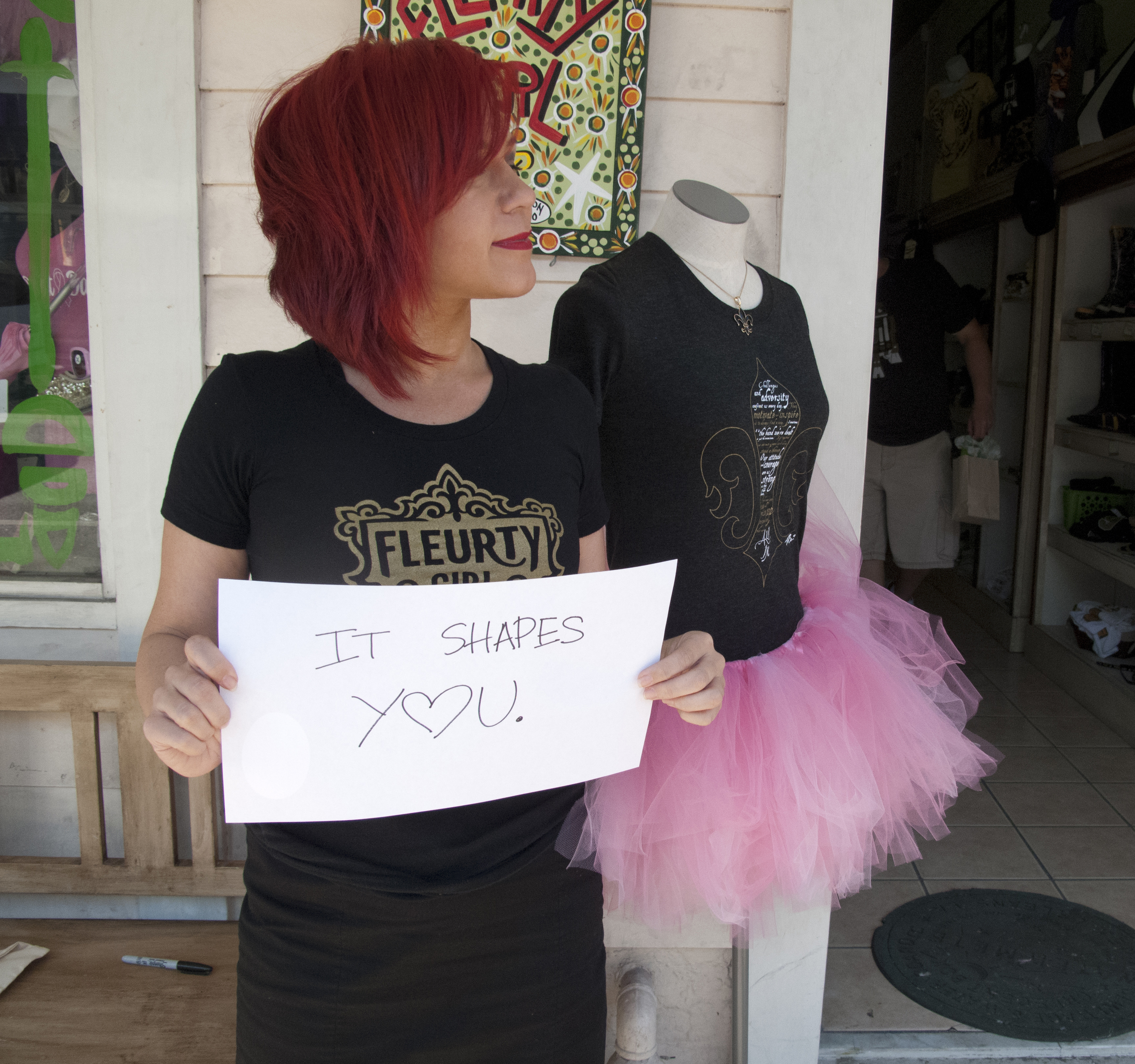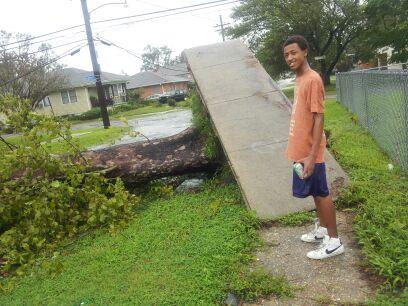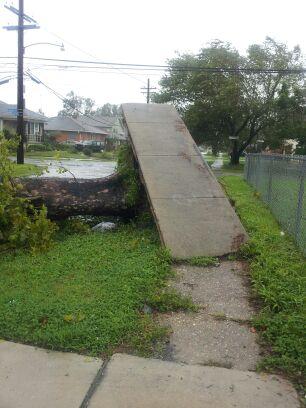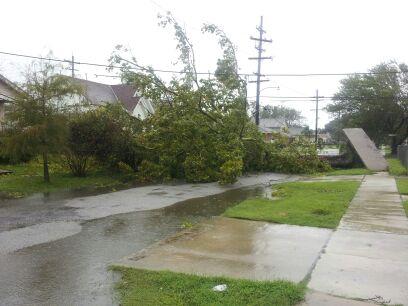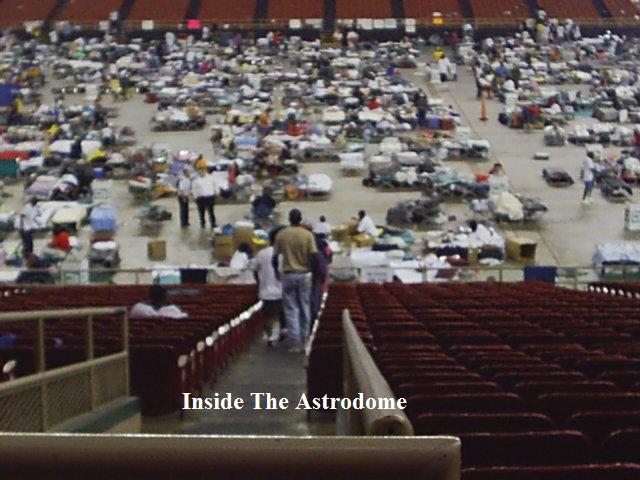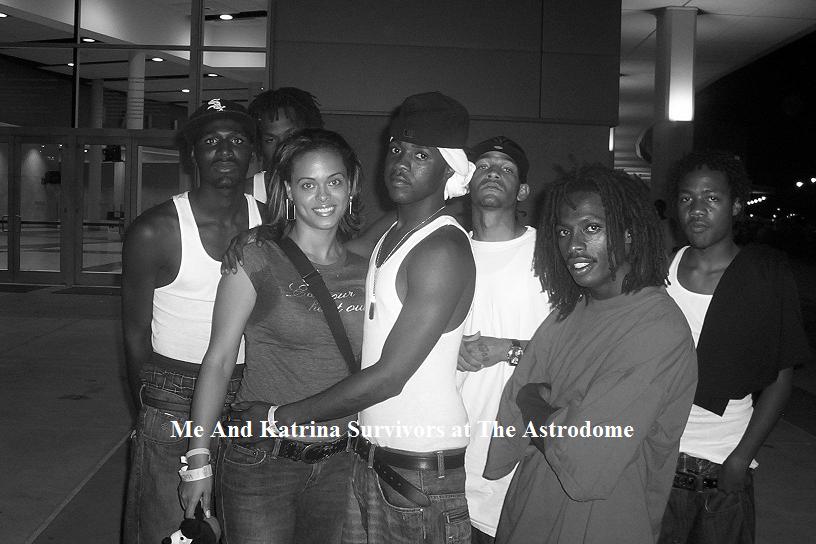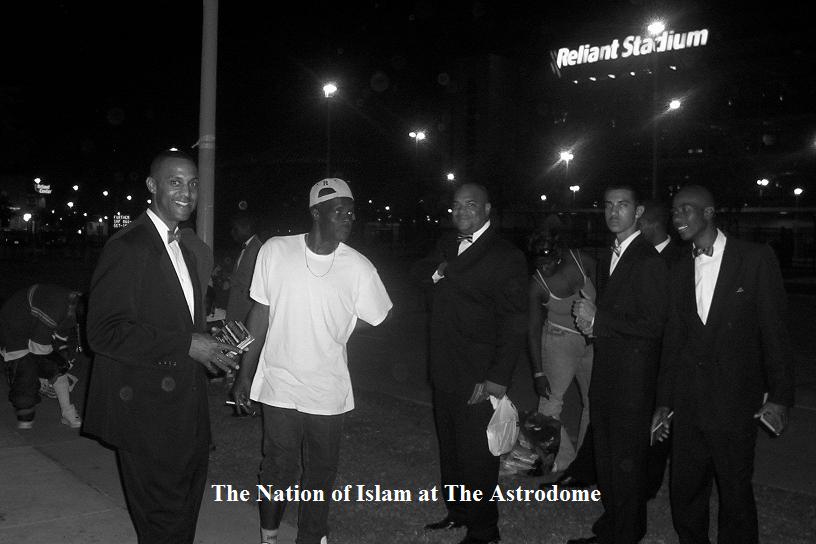Meet Andy Kopsa The Woman Behind NOLA to NYC Tumblr
Andy Kopsa is a freelance journalist who currently resides in New York City. She (yes she) is the creator of the much-talked about Tumblr From NOLA to NYC, which appeared the week after hurricane Sandy. When I came across Kopsa’s Tumblr page via Twitter I immediately wanted to reach out and get to know more about her work. Like Kopsa, I too have a connection to both NOLA and NYC. Though I never lived in NOLA, I was a volunteer during hurricane Katrina while living in Houston, Texas. Over the last several years I’ve collaborated with Katrina survivors on media and research projects. Hurricane Katrina undoubtedly changed my life and fueled my ambitions to be a better storyteller and advocate.
Having recently experienced hurricane Sandy as a resident of New York City and as an Occupy Sandy volunteer, I’ve found myself reflecting on the similarities and differences between hurricanes Katrina and Sandy. I’m beginning to think hurricanes follow me, or perhaps I follow them.
Nonetheless, I’m fascinated by the power of the human spirit to act as a healing mechanism after (un)natural disasters. I’m also incredibly drawn to the ways in which ordinary people, those directly and indirectly affected by natural disaster use social media to create what I call nurture-networks; that is, online/offline support networks cultivated in response to crisis.
I recently had the opportunity to interview Kopsa about NOLA to NYC Tumblr. In addition to discussing her project, she also told me about how disappointed she is with media outlets using images from NOLA to NYC Tumblr without permission. She also talked about being frustrated by various media outlets referring to her as a "he". Kopsa also shares with me how she feels about NOLA seven years after Katrina. In the passages below, you'll learn more about Kopsa, the woman behind the NOLA to NYC Tumblr, and about her plans to continue to support the two cities she calls home; New Orleans and New York City.
TLC: It seems like we share similar experiences having both been affected by hurricane Katrina and hurricane Sandy. What interests you most to the stories of those affected by the hurricanes?
AK: I don’t think it is hurricanes per se. For me, this project was about two of the places I have called home: New Orleans and New York City. Having a deep connection with New Orleans, and with New York it only made sense . I had to do something. I am an investigative reporter who went to photo school so these things just happen with that kind of history!
TLC: You wrote in the “About” section of NOLA to NYC that during Sandy you were in NOLA, and while thinking about your family back in NYC, you thought to create NOLA to NYC via Tumblr. What made you think to use social media like Tumblr as an outlet and as means to connect two geographically separate communities?
AK: Truthfully, because it was easy. I had a Tumblr account for another project in the works featuring women journalists from rural america who moved to the “big city” and it was simple to add another page. I know, not a very sexy answer but the truth. On the road, it is hard at times to get up and run on a blog, new website, etc. Pitching stories on the fly is difficult for me. Tumblr afforded some serious ease since I was consumed with shooting, reporting, and watching The Weather Channel.
TLC: At what point did you realize NOLA to NYC was beginning to pick up viral steam on the Internet?
AK: A friend tweeted a Salon story featuring the project. But, I do publish in a wide variety of places and know writers at Salon so I wasn’t completely surprised. It didn’t seem like a big deal initially. It is when media requests started pouring in from places like NBC Nightly News and other outlets that I was taken aback.
TLC: What insights, if any, have you gained from the NOLA to NYC project? What have you learned that perhaps you weren’t expecting to learn as a result of creating NOLA to NYC?
AK: That the media, of which I am a part, is an incredibly powerful tool. For good or for ill, you have control how you use that tool. In retrospect, I may not have used Tumblr simply because everyone and their monkey’s uncle picked up photos and used them without permission. This started as a deeply personal project, me photographing Katrina survivors, friends. I listened to their stories and went through some personal anguish reporting on and photographing the appalling lack of progress in the seven years since Katrina. NOLA was my home for a handful of years and I love that place. So when people in the media, I am talking small time blogs to national television networks, started using some of the photos without even an email, well, I was none too pleased.
As a reporter who would never dream of using someones images, writings, anything, without permission - or at least a hat tip or link - it disgusts me. People were writing things about me that weren’t true. Like I am a he , which I am not. And, one publication printed that I was a native of New Orleans and a Katrina survivor. Both not true. Nowhere in my personal history will you ever find those kinds of claims. A 5 second google search would have told you I am an Iowa native and a lady. Come to find out the “reporter” picked up my twitter feed and read her own fantasy into my tweets about NOLA to NYC. I asked that next time she write about a person, at the very least, she give a ring-a-ling or drop an email. Off soapbox.
I should mention that I didn’t learn that New Orleanians are incredibly passionate, resilient and down to earth people, that Katrina survivors are bad ass, love their city and will give back until it hurts. I didn’t learn that from this project only because I already knew that.
TLC: Some may argue that NOLA to NYC is just another Internet meme that may lose people’s interest when the next meme comes along. Do you think NOLA to NYC is ‘just another Internet meme’? How do you keep the conversations going even after people lose interest in hurricane narratives?
AK: People are already losing interest. But, that doesn’t really matter. I wasn’t launching the site to springboard a career. I will go about my business. I won a grant from USC Annenberg (Knight Grant on Reporting in Religion and Public Life) to investigate religion and sex education in Mississippi so I need to get back to that. The only conversation I want to continue is the one about seven years later: NOLA is still hobbled. The lower ninth ward is still decimated. The lakefront still bears the scars of Katrina. Half the population is gone. Graft is still a king of New Orleans. We need to look at New Orleans as prologue to the long road back we have here in the wake of Sandy. There are tons of lessons to be learned from how Katrina was handled. We need to be mindful that although the administrations have changed, many of the mechanisms for disaster recovery have not. Private contractors promising victims a brighter tomorrow when what they really are up to is testing out new building materials or upcharging FEMA and the feds. I know, sounds bleak, but this is one of those teachable moments.
TLC: Do you have any plans to expand the outreach of NOLA to NYC offline or to other online spaces? If so, are there ways that other people can continue to support your efforts?
AK: I just made the decision to start selling prints of the original 12 portraits I shot. I will be donating a portion of the profits, if any, to the Ali Forney Center in New York City. A drop in shelter for LGBTQ teens. The center was destroyed in the wake of Sandy. A lot of my reporting in the past dealt with issues of LGBTQ rights and I've donated clothing and other items to the center before. It seems a natural and right fit.
I am also going to Mastic Beach this weekend to take NOLA to NYC care packages to the people hit hard in that area of Long Island. This was brought to my attention by the head of a pop-up charity group called New Orleans Gives Back. The group will be bringing a truck full of useful cleanup and support supplies to Mastic this weekend. The founder of the group asked if I wanted to be a part of it. Of course I did, so I am making little prints and bringing some of the words of love and wisdom from the NOLA to New York project to Mastic. It is a small gesture, but hopefully hearing from people who have been through it will bring a brief moment of comfort.
Many thanks to Andy Kopsa for taking the time to chat with MEDIA MAKE CHANGE.
To purchase prints from the NOLA to NYC project, please visit: http://andykopsa.photoshelter.com
Photos courtesy of Andy Kopsa
Post-Hurricane Sandy Online Resources
A parking lot full of yellow cabs is flooded as a result of Hurricane Sandy on Tuesday, Oct. 30, 2012 in Hoboken, NJ. (via Facebook)
Back in 2005, after hurricane Katrina shattered the Gulf Coast, I began monitoring several online networks created and cultivated by what I called women virtual volunteers. Though Twitter and Facebook weren't around back then, women were created blogs, list servs, and newsgroups in efforts to provide relief support for victims and survivors of hurricane Katrina. This was the first time I witnessed people gathering across time and space to pull their resources online after a natural disaster. It's important to note that at the time, the nurture-networks I looked at were also created in response to lack of support from the federal government, namely FEMA.
Seven years after hurricane Katrina, the country has yet again been devastated by a natural disaster in the form of hurricane Sandy. People along the east coast, and parts of the midwest, are currently assessing widespread damage as a result of a massive storm surge lasting several hours.
As we saw during hurricane Katrina, people have taken to social media to help spread the word about damage and to provide resources for victims and survivors of the storm. However, unlike what we saw during Katrina; that is, when social media looked more like Yahoo! news groups and comments sections of blog posts, those directly and indirectly affected by Sandy have taken to popular social networks like Twitter, Facebook, and even Storify to provide the nation with up-to-date information and online resources. And it's not only traditional journalists and reporters creating these spaces, but also everyday citizens with a cell phone and a wifi connection.
In my continuing efforts to monitor online networks post-Sandy, I've put together a (growing) list of resources that I hope folks will find useful as we begin the arduous process of cleaning up after Sandy. If you have more resources to share, please do so below in the comments section. You may also tweet us @mediamakechange
IMAGES AND STORIES FROM THE STORM
ABC 7 Storify Hurricane Sandy: http://storify.com/EyewitnessNews/hurricane-sandy-1
Storify Users Cover #Sandy: http://storify.com/storify/storify-users-cover-sandy
AcuWeather: Sandy Floods New York City: http://storify.com/breakingweather/photos-sandy-floods-new-york-city-new-jersey
Hurricane Sandy Facebook Group: https://www.facebook.com/pages/Hurricane-Sandy/506493399380778?fref=ts
ORGANIZATIONAL SUPPORT
- Red Cross Hurricane app : http://www.redcross.org/mobile-apps/hurricane-app
- List of currently open Red Cross shelters at: http://www.redcross.org/nss/
- Visit the Red Cross web site: http://www.redcross.org or call 1-800-RED CROSS (1-800-733-2767).
- People should also register on the Red Cross Safe and Well website, a secure and easy-to-use online tool that helps families connect during emergencies: http://www.redcross.org/find-help/contact-family/register-safe-listing
@NotifyNYC on Twitter
- People located in NYC can ‘follow NotifyNYC’ on Twitter, and text 40404 to get @NotifyNYC (http://www.twitter.com/notifyNYC) tweets as text messages.
- Google Crisis map that has good information about Hurricane Sandy as well as shelter information: http://google.org/crisismap/sandy-2012
- A secure, user-friendly web portal that consolidates information about federally funded government assistance to disaster victims, including the ability to apply for FEMA benefits directly online: http://www.disasterassistance.gov
State Offices of Emergency Management
- A list of the emergency management offices in all 50 states plus territories: http://www.fema.gov/regional-operations/state-offices-and-agencies-emergency-management
- The Disaster Distress Helpline (DDH) is the first national hotline dedicated to providing year-round disaster crisis counseling. If you or someone you know has been affected by a disaster and needs immediate assistance, please call this multilingual, crisis support service (available 24/7) at (1-800-985-5990) and SMS (text `TalkWithUs' to 66746). Residents in the U.S. and its territories who are experiencing emotional distress related to natural or man-made disasters: http://disasterdistress.samhsa.gov/ toll-free number for information, support, and counseling. You will be connected to the nearest crisis center.
- Also see The Salvation Army's blog with up-to-date information on hurricane Sandy. http://www.salvationarmyusa.org/usn/www_usn_2.nsf
- You can email nycservice@cityhall.nyc.gov for more information on how to volunteer in your area. http://www.nycservice.org
- Be sure to visit their website BEFORE going to donate blood. Not all centers are open because damage due to the storm. We recommend that you call 1-800-933-2566 or visit www.nybloodcenter.org for donor center hours and the latest information. Thank you for your support. http://www.nybc.org/press-release.do?sid0=60&page_id=152&content-id=785
- Delivers medicines, medical supplies and aid to people in crisis around the world. http://www.americares.org/
- Provides medical assistance to people affected by disaster. http://www.directrelief.org/
Sources: Facebook, CraigConnects, Huffington Post
Related Stories: Hurricane Sandy: Red Cross, Other Relief Organizations See Social Media as 'Double-Edged Sword' For Relief Efforts
NOLA Native Shares Scenes from Hurricane Isaac
Our friend Marcus Akinlana has graciously allowed MEDIA MAKE CHANGE to share his photos from the aftermath of hurricane Isaac. I spoke with Marcus yesterday and he told me that he and his family decided to stay in NOLA, bunker down and wait out the storm. Their homes sustained minor damage, but surrounding areas weren't as fortunate. Marcus told me that Plaquemines Parish got hit harder this time around than in 2005 when hurricane Katrina ravished the city. It's hard not to remember Katrina's devastation while looking at the scenes and images below.
I asked Marcus if there is anything we can do to help support recovery efforts. Marcus told me,
"You are a sweetheart! I don't know what to tell you but when it all calms down make a trip to NOLA and come party with us. That's what we like. Come join us on Sunday evening in Congo Square. That'll help. When you can afford it and make the time, come."
As I plan for another trip to NOLA, I'll continue to keep my neighbors the the south in my thoughts and mediations. You can also help by contacting the Red Cross at 1-800-RED CROSS or texting "REDCROSS" to 90999 to make a $10 donation. You can also follow @NOLANews on Twitter for further updates.
Please share your resources, information, and stories below in the comments section and on Twitter using the #RememberKatrina hashtag, and by following @mediamakechange.
Related stories
BP to donate $1 million for Isaac recovery efforts (LSU Reveille)
Verizon Wireless supports hurricane Isaac relief (Sacramento Bee)
#RememberKatrina: A National Conversation Through Digital Storytelling
In 2005 I didn't know what digital storytelling meant. The term had never crossed my mind. I just remember feeling compelled to tell a story with my old Panasonic Camcorder PV-L779D. I was a citizen journalist with a Myspace blog who aspired to be a documentary filmmaker.
Six months fresh out of college and less than a year into my first real teaching job in Houston, Texas, I found myself tracking cable news and Internet stories about the aftermath of hurricane Katrina. Twitter and Facebook weren't in my life at the time so Bill O'Reilly, Anderson Cooper, and Yahoo! News were the next best things. In one day, I had listened to over fifty televised broadcasts coming out of NOLA that highlighted missing children, dying grandmothers, and dead animals. I became obsessed with these stories to the point at which I too became depressed. I found refuge in blogging on Myspace about my experiences meeting survivors, which would later be archived in the Hurricane Digital Memory Bank. But as a twenty-four-year-old middle-school English teacher, I struggled to talk with my students about a natural disaster that happened 350-miles away. I couldn't articulate the calamity of a national tragedy using only words.
When I heard that survivors from NOLA were being bussed to the Houston Reliant Center--my backyard at the time, I dusted off my Panasonic camcorder and headed down 288-South. I didn't know what story I wanted to tell, I just knew that I wanted to talk with survivors and document their stories without the punditry, political diatribes, corporate influence, and commercial breaks. I also wanted to tell my story as a volunteer with the Red Cross.
During those few weeks of volunteering, I had the opportunity to get to know survivors through storytelling. I listened to them talk about how lucky they were to be rescued from the top floors of their homes and rooftops. They told me about losing all confidence in their local and state governments. Some stories I heard while standing in-between cots. Other stories I captured on camera while standing outside of what was then called "Reliant City".
After hours of volunteering and recording, I returned home mentally drained and emotionally depleted. I crawled into bed and turned the camera on myself. "This shit's getting to me," I said whipping away tears. "I can't go to sleep because I keep thinking about these people. I just want to help them." I was overwhelmed by the reality that the lives of 70,000+ U.S.-Americans would be consequentially altered forever. I knew that our country would never be the same. She'd be forced to confront a sordid past of racial inequality and political ineptitude, long before President Obama would become president 3 years later.
Looking back at the moment I broke down on camera, I realize now that I sounded like a naive and idealistic child. I thought that maybe documenting my tears and curses on camera could make a difference. I didn't realize I was up against a nation of forgetters.
The Statistics
Since hurricane Katrina there remains approximately 35,700 blighted homes and empty lots in New Orleans alone. The NOPD recently reported a 10% increase in overall crime in the city. Residents in neighboring states like Mississippi who were also affected by Katrina have seen noticeable spikes in insurance payments. For many neighborhoods affected by Katrina all that remain are cement blocks and overgrown weeds where homes once stood. Among the most devastated neighborhoods in NOLA is the Lower Ninth Ward, comprised of 95% African Americans. Despite $14.5 billion in floodgate and levee reconstruction, neighborhoods like Lower Ninth Ward remain noticeably neglected. Though NOLA has seen a diverse population increase since hurricane Katrina, its economic, social, and environmental trends remain troubling. Job cuts in major industries like tourism, oil and gas, and shipping, coupled with unaffordable housing costs, high crime rates, and loss of wetlands contribute to the mounting problems the Big Easy currently confronts since hurricane Katrina.
In efforts to remember our history, MEDIA MAKE CHANGE has launched #RememberKatrina, a national conversation through digital storytelling and social media. All this week, beginning Monday, August 27th through Friday, August 31st, MEDIA MAKE CHANGE (@mediamakechange) will engage in a national conversation with people around the country affected by hurricane Katrina. We begin our conversation on Twitter with several invited guests who will talk about their experiences and research related to hurricane Katrina. The goal is to get as many people talking on social networks, blogs, and via digital video. We believe that the power of storytelling can influence social and political transformation.
#RememberKatrina Is Personal
When I look back at the beginning of my journey as a media maker and educator, I see hurricane Katrina. I recognized that the events leading up to, during, and after the storm inform my current practices as an educator and media maker. These events made me a stronger listener, and in turn, a better storyteller. I learned how to pay attention to what wasn't being said so I could seek out what actually should be told. I developed a sharper eye so I could see through the propaganda and towards counter-narratives for truth-telling.
Since 2006, I've used my amateur documentary about hurricane Katrina, A Region of Survivors to connect with various communities. I've presented my work at universities, community centers, and conferences across the country. As a result, I've engaged professors, students, and community organizers to think critically about social, economic, and political issues relating to the most devastating (un)natural disaster in modern U.S.-history. I parlayed digital documentary, and subsequent other media, to build a community of rememberers. All this because of a storm and some broken levees.
Tell us your stories and join the conversation on Twitter all this week using the #RememberKatrina hashtag.
Lucky: A Katrina Survivor
The following entry is from a 2005 Myspace blog post that I wrote on the first night I returned home from volunteering with the Red Cross in Houston, Texas. The events took place some time around two weeks after hurricane Katrina struck the Gulf Coast. Please do not re-print or re-distribute without express written consent.
Lucky and me (2005)
Current mood: nostalgic
Category: Blogging
A true story.
Every night I stepped foot inside the Astrodome in Houston, Texas I was draped with grief from thousands of New Orleans survivors. Each night I walked away from the Dome I was determined to cleanse the muddy perception I had of my own life.
I walked self-consciously between the cramp isles of Red Cross cots spread across the Dome floor. An elderly man in a wheel chair followed closely behind. When I saw him I thought he would be a perfect person to approach since it was our job as volunteers to initiate conversation with residents staying at the Astrodome. Some survivors were in need of blankets and toiletries, others just needed someone to talk to. I've never been comfortable initiating conversations with complete strangers, especially knowing that they've been through so much hell. I couldn't possibly empathize with what the survivors have just gone through. I was nervous and felt out a place. Half of me didn't want to be there.
The old man slowly wheeled his way towards me. I still couldn't speak. Then my father, who came along to volunteer with me, turned toward the old man.
"Hey buddy, how ya doin?" He asked.
Daddy could talk to anyone. I secretly envy him for that.
I was glad Daddy came along, not just as buffer, but because it's been a long time since we had a chance to do something together as equals. I've spent so much of my adult years trying to be the mother to my father instead of just being his daughter.
I stood there looking at the old man, feeling invisible, wanting to say the right thing, but couldn't. Daddy spoke again.
"How did you get here?" Daddy asked.
"Luck," the old man responded.
Daddy asked the old man his age. When he said that he was born in 1930, an immediate pact was formed between the two of them.
"You were born in 1930?" Daddy asked as if he didn't hear him right the first time.
The old man nodded.
"So was I."
Daddy shook the old man's hand, and within an instant that unspoken gesture launched a spontaneous camaraderie between the two and forced me even further away from their pact. Their connection made me inadequate. I wanted to bond too. That was my job as a volunteer.
The old man told us about how he escaped from his home in New Orleans just in time before the water began to swallow his house. He was sleeping when the hurricane hit landfall. People from outside were screaming for him to get out of the house. Something, he told us, woke him up . The next thing he remembered he was being rescued by boat floating down the street.
"I'm just grateful my wife died years before all this. She wouldn't have made if she was there with me when Katrina hit. She was sickly." He told us.
He talked about his late wife as if she was still alive.
"We got married when we was young. It's our 50th anniversary this year." He told us. I looked at Daddy. His eyes were glazed over.
The old man told us that the he was rescued by a U.S. Coast Guard, who then took him to the Convention Center in New Orleans. He spoke about the horrific conditions inside the Convention Center. No electricity, feces and garbage mounting as the hours passed. He talked about hearing rumors that little girls were being raped at night. He felt abandoned.
"Horrible, just horrible!" He shouted while shaking his head.
He said that people feared they would die and blend in with the already dead. Optimism quickly turned into fatigue. Hopelessness took over and darkness filled the arena, forcing imaginations to scamper untamed.
I stood frozen in the telling of his story. My eyes locked in to his words. Though I couldn't hear what he was saying, I could see every syllable of every word drip from his mouth. It was the rhythm of his words that held me in slow motion. The more he reflected upon a history only two weeks old, the lower his eyes fell toward his lap. He was visibly tired.
"I don't have nothing no more. All my things is gone."
"What all did you lose?" I finally asked, breaking my stream of conscious thoughts.
He told us that he lost his home and everything in it.
"But even though my stuff is gone, I'm lucky cause I still got my life. I'm so lucky."
After an hour of talking, Daddy and I decided to pack up our things. It was getting late and volunteer hours were almost over. Before I said goodbye, I promised the old man that I would come back to visit. The old man looked at me.
"You coming tomorrow, right?" He asked.
"Of course. I'll be here," I said.
He told me to reach down under his bed. He had a gift for me. It was a rose. Some family members on the other side of the Dome had stopped by his cot earlier with flowers. He told me to take one just in case we don't see each other again.
Daddy and I left the Dome around 9 o'clock. During our ride home we talked the entire time like two old war vets reminiscing after decades of being apart. When I realized that we never got the old man's name, Daddy said, "we'll call him Lucky."
Tell us your story on Twitter using the #RememberKatrina hashtag
Follow us @mediamakechange

